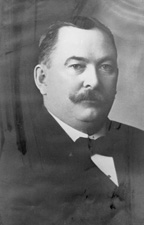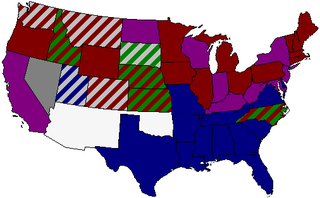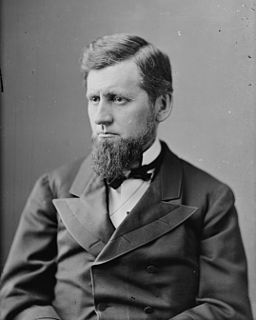
Reed Smoot was a businessman and apostle of The Church of Jesus Christ of Latter-day Saints when he was elected by the state legislature to the United States Senate in 1902; he served as a Republican senator from 1903 to 1933. From his time in the Senate, Smoot is primarily remembered as the co-sponsor of the 1930 Smoot–Hawley Tariff Act, which increased almost 900 American import duties. Thomas Lamont, a partner at J.P. Morgan at the time said, "That Act intensified nationalism all over the world". The Smoot-Hawley Tariff Act is widely regarded as one of the catalysts for the Great Depression.

Frank Jenne Cannon was the first United States Senator from Utah, who served from 1896 to 1899.

Although the 17th Amendment was not passed until 1913, some states elected their Senators directly before its passage. Oregon pioneered direct election and experimented with different measures over several years until it succeeded in 1907. Soon after, Nebraska followed suit and laid the foundation for other states to adopt measures reflecting the people's will. By 1912, as many as 29 states elected senators either as nominees of their party's primary or in conjunction with a general election.

Thomas Kearns was an American mining, banking, railroad and newspaper magnate. He was a United States Senator from Utah from 1901 to 1905.
The 1863 United States Senate election in New York was held on February 3, 1863, by the New York State Legislature to elect a U.S. Senator to represent the State of New York in the United States Senate.
The 1881 United States Senate election in New York was held on January 18, 1881, by the New York State Legislature to elect a U.S. Senator to represent the State of New York in the United States Senate.
The 1893 United States Senate election in New York was held on January 17, 1893, by the New York State Legislature to elect a U.S. Senator to represent the State of New York in the United States Senate.
The 1899 United States Senate election in New York was held on January 17, 1899, by the New York State Legislature to elect a U.S. Senator to represent the State of New York in the United States Senate.
The 1905 United States Senate election in New York was held on January 17, 1905, by the New York State Legislature to elect a U.S. Senator to represent the State of New York in the United States Senate.
The 1911 United States Senate election in New York was held from January 17 to March 31, 1911, by the New York State Legislature to elect a U.S. Senator to represent the State of New York in the United States Senate.

The United States Senate elections of 1896 and 1897 were elections in which the Democratic Party lost seven seats in the United States Senate, mostly to smaller third parties.

The United States Senate elections of 1900 and 1901 were elections in which the Democratic Party gained two seats in the United States Senate, and which corresponded with President William McKinley's landslide re-election. By the beginning of the next Congress, however, the Republicans gained five additional seats, giving them a ten-seat majority.

The United States Senate elections of 1904 and 1905 were elections that coincided with President Theodore Roosevelt's landslide election to a full term. Party share of seats remained roughly the same, when including vacancies and appointments, and the Republicans retained a significant majority over the Democrats.
The United States Senate elections of 1880 and 1881 were elections that coincided with the presidential election of 1880, and had the Democratic Party lose five seats in the United States Senate. The newly elected Readjuster senator caucused with the Republicans, and the Republican Vice President's tie-breaking vote gave the Republicans the slightest majority. All of that changed September 19, 1881 when the Vice President ascended to the Presidency and the Senate became evenly-divided.
The United States Senate elections of 1886 and 1887 were elections that had the Republican Party lose two seats in the United States Senate. At the beginning of the 50th Congress, therefore, Republicans had the slimmest possible majority due to a vacant Democratic seat: 38 out of 75 seats. Once that vacancy was filled, Republicans maintained control as the single Readjuster Senator caucused with them.
The United States Senate elections of 1890 and 1891 were elections in which the Republican Party lost four seats in the United States Senate, though still retaining a slim majority. That majority was increased, however, upon the admission of two more states with Republican senators.
The United States Senate elections of 1892 and 1893 were elections which, corresponding with former Democratic President Grover Cleveland's return to power, had the Republican Party lose nine seats in the United States Senate and lose its majority to the Democratic Party. The Democratic majority, however, was minimal and didn't last past the next Congress.

Alfred William McCune was an American railroad builder, mine operator, and politician from the state of Utah. Owner of several retail and construction businesses, he helped build the Montana Central Railway and a portion of the Utah Southern Railroad, founded the Utah and Pacific Railroad, and built railways in Peru, among other projects. He also owned many profitable mines in Canada, Montana, Peru, and Utah, including the Payne Mine—which paid the most dividends in the history of British Columbia. Late in life, he co-founded the Cerro de Pasco Investment Company, which became the largest copper investor in South America and the largest American investor in Peru until it was nationalized in 1974. He was one of Utah's first millionaires.
The United States Senate elections of 1862 and 1863 were elections during the American Civil War in which Republicans increased their control of the U.S. Senate. The Republican Party gained three seats, bringing their majority to 66% of the body. Also caucusing with them were Unionists and Unconditional Unionists. As many Southern states seceded in 1860 and 1861, and members left the Senate to join the Confederacy, or were expelled for supporting the rebellion, seats were declared vacant. To establish a quorum with fewer members, a lower total seat number was taken into account.
On January 12, 1898, the Ohio General Assembly met in joint convention to elect a United States Senator. The incumbent, Mark Hanna, had been appointed by Governor Asa Bushnell on March 5, 1897, to fill the vacancy caused by the resignation of John Sherman to become Secretary of State to President William McKinley. Hanna's appointment was only good until the legislature met and made its own choice. The legislature elected Hanna over his fellow Republican, Cleveland Mayor Robert McKisson, both for the remainder of Sherman's original term and for a full six-year term to conclude in 1905.

















